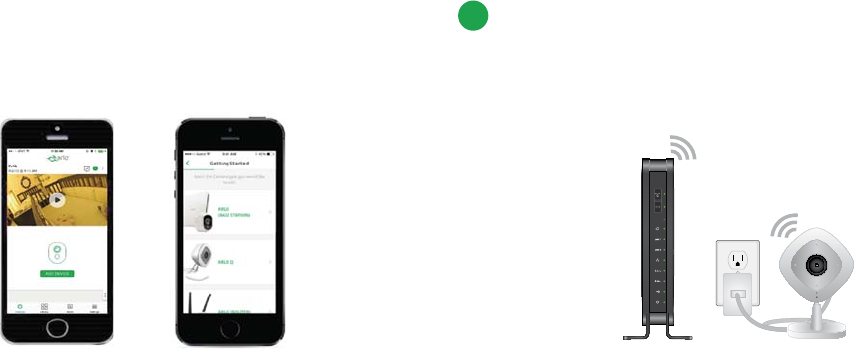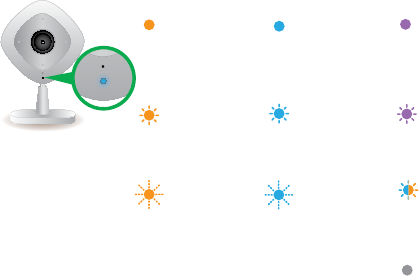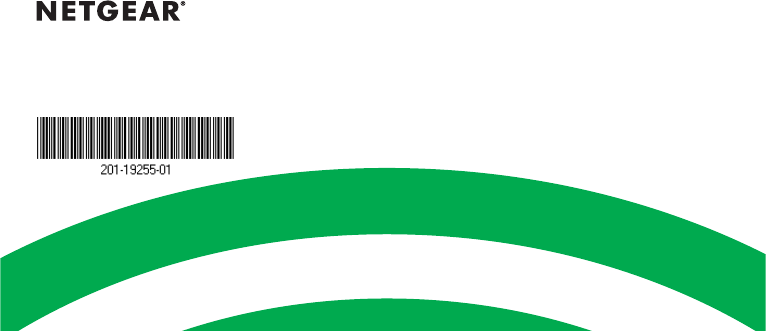Netgear orporated 15200316 Arlo Q User Manual Arlo Quick Start Guide
Netgear Incorporated Arlo Q Arlo Quick Start Guide
User Manual rev.pdf

1
Quick Start Guide

3
2
Welcome
Thank you for choosing Arlo.
Getting started is easy.

5
4
What’s Included
Arlo Q camera
4 Mounting
screws
USB cable USB power
adapter
Wall-mount
plate
TOP
Connect one end of the USB cable to the port on the camera.
Plug the other end of the USB cable into the adapter.
Plug the USB adapter into a wall socket and wait for the
camera LED to blink amber.
Plug In Your Camera
1

7
6
Get the App
For the best experience, download the Arlo app for your
smartphone by scanning the QR code below or searching for
“Arlo” in the app store.
https://arlo.netgear.com
2Get a New Account
Launch the app from
your smartphone and
tap the New System
Setup button. Follow the
onscreen instructions.
3
Or from a computer, visit
https://arlo.netgear.com/#/login
and click the New System Setup
button. Select Arlo Q.
Already have an account? See Add Devices to an Existing
Account on page 8.

9
8
Launch the Arlo app and log in to your account.
Tap the Add Device button, select Arlo Q, and follow the onscreen
instructions.
Connect Your Camera
4
Follow the onscreen instructions from either the Arlo app or from
a computer to connect your camera directly to your WiFi router.
Note: If you own an Arlo wire-free system, do not connect your
Arlo Q camera to the Arlo base station.
Add Devices to an Existing Account

11
10
Place or Mount Your Camera
You can place your camera on a shelf or other flat surface, or
you can mount it on the wall.
5
Note: The camera base includes a magnet that can help position a
camera on a metal surface.
If you are mounting the camera on a wall, place the wall plate
and secure it in place with four screws.
Slide the camera into the wall plate.

13
12
You’re Done!
Congratulations! Your Arlo camera is set up and ready to go.
To view useful tutorial videos, find troubleshooting tips, or get support,
visit http://support.arlo.com.
Camera LED Guide
Solid blue
The camera is
powered on and is
connected to Arlo
servers.
Slow blinking
blue
The camera is
connecting to a
WiFi network.
Fast blinking
amber
The camera is not
connected to a
WiFi network yet.
Solid amber
The camera is
booting up.
O
The camera is
powered o.
Solid purple
The camera is
connected to a WiFi
network however it
is not connected to
the Internet.
Blinking purple
The camera is too
far away from the
router.
Blinking blue/
amber
A firmware update
is in progress. DO
NOT TURN OFF THE
CAMERA.
Slow blinking
amber
The camera is
powered on and is
ready for setup.
Fast blinking
blue
The camera is
connecting to Arlo
servers.

15
14
Notes Notes

16
©NETGEAR, Inc., NETGEAR, the NETGEAR Logo, and
Arlo are trademarks of NETGEAR, Inc.
Compliance
For the current EU Declaration of Conformity, visit
http://kb.netgear.com/app/answers/detail/a_id/11621/.
For regulatory compliance information, visit
http://www.netgear.com/about/regulatory/.
350 East Plumeria Drive
San Jose, CA 95134, USA
September 2015
Federal Communication Commission Interference Statement
This device complies with Part 15 of the FCC Rules. Operation is subject to
the following two conditions: (1) This device may not cause harmful
interference, and (2) this device must accept any interference received,
including interference that may cause undesired operation.
This equipment has been tested and found to comply with the limits for a
Class B digital device, pursuant to Part 15 of the FCC Rules. These limits are
designed to provide reasonable protection against harmful interference in a
residential installation. This equipment generates, uses and can radiate radio
frequency energy and, if not installed and used in accordance with the
instructions, may cause harmful interference to radio communications.
However, there is no guarantee that interference will not occur in a
particular installation. If this equipment does cause harmful interference to
radio or television reception, which can be determined by turning the
equipment off and on, the user is encouraged to try to correct the
interference by one of the following measures:
- Reorient or relocate the receiving antenna.
- Increase the separation between the equipment and receiver.
- Connect the equipment into an outlet on a circuit different from that
to which the receiver is connected.
- Consult the dealer or an experienced radio/TV technician for help.
FCC Caution: Any changes or modifications not expressly approved by the
party responsible for compliance could void the user's authority to operate
this equipment.
This transmitter must not be co-located or operating in conjunction with any
other antenna or transmitter.
Radiation Exposure Statement:
This equipment complies with FCC radiation exposure limits set forth for an
uncontrolled environment. This equipment should be installed and operated
with minimum distance 20cm between the radiator & your body.
Industry Canada statement:
This device complies with RSS-247 of the Industry Canada Rules. Operation is
subject to the following two conditions: (1) This device may not cause
harmful interference, and (2) this device must accept any interference
received, including interference that may cause undesired operation.
Ce dispositif est conforme à la norme CNR-247d'Industrie Canada applicable
aux appareils radio exempts de licence. Son fonctionnement est sujet aux
deux conditions suivantes: (1) le dispositif ne doit pas produire de brouillage
préjudiciable, et (2) ce dispositif doit accepter tout brouillage reçu, y
compris un brouillage susceptible de provoquer un fonctionnement
indésirable.
Caution :
(i) the device for operation in the band 5150-5250 MHz is only for indoor use
to reduce the potential for harmful interference to co-channel mobile
satellite systems;
(ii) high-power radars are allocated as primary users (i.e. priority users) of
the bands 5250-5350 MHz and 5650-5850 MHz and that these radars could
cause interference and/or damage to LE-LAN devices.
Avertissement:
les dispositifs fonctionnant dans la bande 5 150-5 250 MHz sont réservés
uniquement pour une utilisation à l’intérieur afin de réduire les risques de
brouillage préjudiciable aux systèmes de satellites mobiles utilisant les
mêmes canaux;
(ii) De plus, les utilisateurs devraient aussi être avisés que les utilisateurs de
radars de haute puissance sont désignés utilisateurs principaux (c.-à-d.,
qu’ils ont la priorité) pour les bandes 5 250-5 350 MHz et 5 650-5 850 MHz et
que ces radars pourraient causer du brouillage et/ou des dommages aux
dispositifs LAN-EL.
Radiation Exposure Statement:
This equipment complies with IC radiation exposure limits set forth for an
uncontrolled environment. This equipment should be installed and operated
with minimum distance 20cm between the radiator & your body.
Déclaration d'exposition aux radiations:
Cet équipement est conforme aux limites d'exposition aux rayonnements IC
établies pour un environnement non contrôlé. Cet équipement doit être
installé et utilisé avec un minimum de 20 cm de distance entre la source de
rayonnement et votre corps.